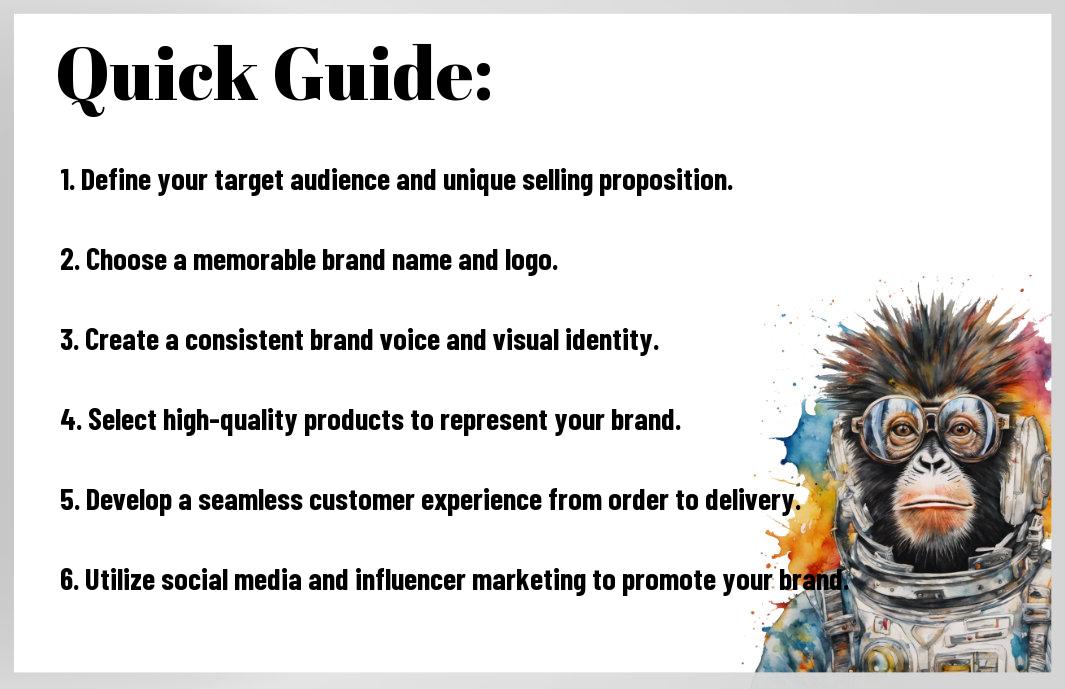The Ultimate Guide To Developing A Strong Dropshipping Brand Strategy
Most aspiring dropshippers plunge into the e-commerce world without a clear brand strategy, risking lost potential and profits. Crafting a strong brand strategy is not just an option – it’s a necessity for success in the competitive market. This comprehensive guide will walk you through the imperative steps and strategies to establish a successful dropshipping brand, from defining your brand identity to enhancing customer loyalty. By the end of this guide, you’ll be equipped with the knowledge and tools needed to set your dropshipping business apart and build a strong, recognizable brand that resonates with your target audience.
Key Takeaways:
- Branding Consistency: Ensure consistency in your brand messaging, logo, color scheme, and overall brand image across all platforms.
- Unique Value Proposition: Identify and highlight what sets your dropshipping business apart from competitors to attract customers.
- Customer Experience: Focus on providing excellent customer service, quick response times, and seamless purchasing experience to build trust and loyalty.
- Quality Product Selection: Curate a selection of high-quality products that align with your brand image and cater to your target audience’s needs.
- Effective Marketing Strategy: Utilize social media, influencer partnerships, content marketing, and email campaigns to increase brand visibility and drive sales.
- Brand Storytelling: Develop a compelling brand narrative that resonates with consumers, evokes emotions, and connects them to your products on a deeper level.
- Adaptability: Stay nimble and adaptable in response to market trends, consumer feedback, and changes in the industry to ensure long-term success.


Understanding Dropshipping Brand Strategy
Definition and key components
It is crucial to understand the concept of dropshipping brand strategy to effectively build and maintain a successful online business. Any strong brand strategy is built upon a clear understanding of the target audience, unique selling proposition (USP), brand values, and competitive landscape.
Types of brand strategies for dropshipping
On the journey of developing a strong dropshipping brand strategy, it is necessary to explore different types of strategies that can help propel your business forward. Any understanding of the various brand strategies such as niche branding, private labeling, white labeling, and exclusive brand lines can provide valuable insights to help you stand out in the crowded e-commerce market. After mastering these strategies, you can create a unique brand identity that resonates with your target customers.
| Niche Branding | Targeting a specific market segment with specialized products |
| Private Labeling | Offering products manufactured by a third party under your brand name |
| White Labeling | Rebranding generic products as your own to sell under your brand |
| Exclusive Brand Lines | Creating unique products exclusively available through your brand |
Another important aspect to consider is the consistency and coherence of your brand across all touchpoints. It is necessary to maintain a strong and unified brand image to build trust and loyalty with your customers. After establishing a clear brand strategy, you can effectively communicate your brand’s values and unique offerings to attract and retain customers in the competitive e-commerce landscape.
Step-By-Step Guide to Developing Your Brand
| Identifying your target market | Crafting your brand’s unique value proposition |
Identifying your target market
Clearly defining your target market is crucial for the success of your dropshipping brand. Understand who your ideal customers are, their demographics, preferences, and buying behavior. Conduct market research to gather insights that will help you tailor your brand to meet their needs effectively.
Crafting your brand’s unique value proposition
Little can set your dropshipping brand apart from the competition like a compelling unique value proposition. Clearly articulate what makes your brand unique, why customers should choose you over others, and the benefits they can expect from your products or services.
Value proposition: Highlight the key reasons why your brand is the best choice for customers. Communicate how your products or services solve their problems or improve their lives in a way that competitors can’t match.
Designing a memorable brand identity
While designing your brand’s identity, focus on creating a consistent visual language that reflects your brand’s values and resonates with your target audience. Develop a unique logo, color palette, typography, and other visual elements that will make your brand instantly recognizable.
Brands: Ensure that your brand elements are cohesive across all platforms, from your website to social media profiles. Consistency in branding helps build trust and recognition among customers.
Implementing your brand strategy across platforms
Identity plays a crucial role in implementing your brand strategy across platforms. Ensure that your brand’s voice, messaging, and visuals are consistent on all online and offline channels. This cohesive approach reinforces your brand’s values and creates a memorable experience for customers at every touchpoint.
Memorable: Make sure that your brand resonates with customers on all platforms, from your website to social media, ensuring a consistent brand experience that builds trust and loyalty.
Strategies for Long-Term Success
Tips for maintaining brand consistency
Unlike short-term success, long-term success in dropshipping requires a strong brand strategy that is consistent across all touchpoints. Maintaining brand consistency is crucial for building trust and loyalty with your customers. This involves keeping your brand messaging, visual identity, and customer experience consistent.
- Regularly review and update brand guidelines
- Train your team on brand standards
- Monitor customer feedback and adjust accordingly
This ensures that your brand remains recognizable and resonates with your target audience. By keeping your brand consistent, you establish a strong foundation for long-term success in the competitive dropshipping industry.
Adapting and evolving your brand strategy
For a dropshipping brand to stay relevant and competitive in the long run, it needs to constantly evolve and adapt its brand strategy to align with changing market trends and consumer preferences. Adapting and evolving your brand strategy involves analyzing data, gathering customer insights, and being willing to make necessary adjustments to meet the evolving needs of your audience.
A proactive approach to brand evolution can help you stay ahead of the curve and capitalize on emerging opportunities. By staying agile and adaptable, you can ensure that your brand remains relevant and engaging in the ever-changing digital landscape.
Analyzing Your Brand Strategy
Factors to consider for brand evaluation
Now is the time to critically evaluate your brand strategy to ensure that it aligns with your business goals and resonates with your target audience. When analyzing your brand strategy, consider the following factors:
- Brand identity: Does your brand effectively communicate your values and mission?
- Competitive analysis: How does your brand differentiate itself from competitors?
- Customer perception: Are your target customers responding positively to your brand?
- Consistency: Is your brand messaging consistent across all channels?
Any inconsistencies or weaknesses in these areas could indicate the need for adjustments in your brand strategy.
Pros and cons of various brand strategies
On examining different brand strategies, it is important to weigh the pros and cons of each approach to determine what will work best for your dropshipping business. Here is a breakdown:
| Brand Strategy | Pros and Cons |
| Private Label | Strong brand identity, Higher profits, Control over product quality; Requires significant investment, Limited scalability |
| Reselling | Low initial investment, Wide product selection; Limited profit margins, Dependency on suppliers |
With brand strategies, understanding the advantages and disadvantages of each can help you make an informed decision that aligns with your business objectives. Consider the risks and rewards associated with each strategy before committing to one.
Summing up
Following this comprehensive guide on developing a strong dropshipping brand strategy will set you on the path to success in the competitive e-commerce landscape. By focusing on building a unique brand identity, understanding your target audience, creating a seamless customer experience, and optimizing your marketing efforts, you will be able to establish a profitable dropshipping business. For more in-depth insights and strategies, check out The Ultimate Guide to Launching a Successful Dropshipping Business.
FAQ
Q: What is dropshipping?
A: Dropshipping is a business model where a store doesn’t keep the products it sells in stock. Instead, when a store sells a product, it purchases the item from a third party and has it shipped directly to the customer.
Q: Why is developing a strong brand strategy important in dropshipping?
A: Developing a strong brand strategy in dropshipping is crucial to stand out in a competitive market, build customer trust, and increase brand loyalty.
Q: How can I differentiate my dropshipping brand from competitors?
A: To differentiate your dropshipping brand, focus on your unique value proposition, branding elements, customer experience, and marketing strategies that set you apart from competitors.
Q: What elements should be included in a strong dropshipping brand strategy?
A: A strong dropshipping brand strategy should include a clear brand identity, target audience definition, unique selling propositions, brand messaging, visual branding elements, and consistent brand communication across all channels.
Q: How can I build brand credibility in dropshipping?
A: To build brand credibility in dropshipping, prioritize product quality, excellent customer service, transparent policies, customer reviews, social proof, and ethical business practices.
Q: Why is it imperative to establish a brand voice in dropshipping?
A: Establishing a brand voice in dropshipping helps create a consistent brand personality, connect with your target audience on a deeper level, and enhance brand recognition and recall.
Q: How can I market my dropshipping brand effectively?
A: To market your dropshipping brand effectively, utilize a mix of digital marketing strategies such as social media marketing, influencer partnerships, content marketing, SEO, email marketing, and paid advertising to reach and engage your target audience.







